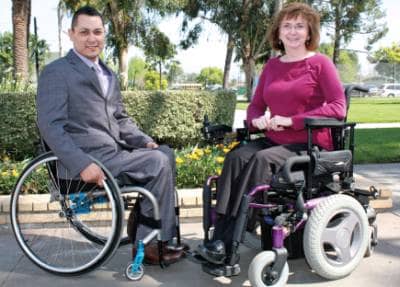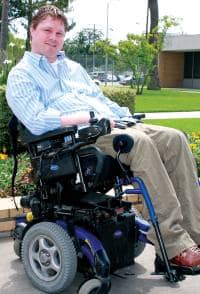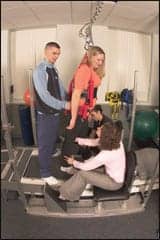
Gilbert Salinas, left, the patient advocate at Rancho Los Amigos, uses a manual wheelchair. Terry Reimer, SLP, in a power wheelchair, is a speech-language therapist at Rancho Los Amigos.
Each year, the therapists who participate in the neurologic residency program at Rancho Los Amigos National Rehabilitation Center, Downey, Calif, spend part of 6 months working with the physical therapists in the seating center. At the end of the program last year, the residents presented me with a small bucket that was exactly 4 inches deep—these residents were sharing that they had understood one of the core messages that I had tried to teach.
A significant posteriorly sloped seat, commonly referred to as “bucket seating,” can critically impact the stability of persons sitting in a wheelchair. The concept of setting up a person’s wheelchair with a posterior seat inclination is not new, but advocating for a 4-inch difference as a standard between the front and rear seat height for most users, including power wheelchair users, might be.
STABILIZING THE PELVIS
The foundation for this argument is that sitting in a wheelchair with a stable pelvis is critical for balance, function, and mobility. A stable pelvis requires that the person is sitting with posterior thighs fully supported by the seat and the person has firm back support. Curtis et al showed that stabilization of the pelvis and trunk is necessary for a person to complete work from a wheelchair.1 Further stability is achieved through a posteriorly inclined seat and upright lumbar support that fixes the pelvis in place. Hastings et al showed that manual wheelchairs with a posterior seat inclination (difference between the front and rear seat height) of 10 cm (4 inches) allowed wheelchair users to sit with decreased forward head position, decreased shoulder protraction, decreased posterior pelvic tilt, and improved height of overall reach.2 A common concern is that a posteriorly inclined seat may increase sitting pressure; however, Maurer et al demonstrated that there is no meaningful evidence that squeezing a wheelchair frame increases seat interface pressures and therefore does not create an added risk to develop a pressure sore.3

Comedian Jay Cramer is a patient advisor to Rancho Los Amigos. He is seated in a tilted power wheelchair.
Manual wheelchair manufacturers have long built wheelchairs that offer the ability to adjust the seat angle and maintain upright back support. On most chairs for active users, a bucketed sitting position can be set by lowering the rear of the seat relative to the front. Once the desired sitting angle is achieved, the back angle can then be reset to an upright position. On many wheelchairs, these adjustments can be made with common tools and without needing new parts. Adjustments can be made quickly and as often as necessary until an optimal position is achieved. Manufacturers of manual wheelchairs offer the option of setting the wheelchair rear height and front seat height on the order form. The ease of ordering and adjustability of the chair are an acknowledgement by the manufacturer of the value of seat angle to the end user.
It is not true, however, that power wheelchairs and manual tilt chairs have the same capability as the high-end manual wheelchair. The standard seat inclination on most power wheelchairs is usually set either to level (0 inches) or with only a slight 5º degree (1 inch) posterior incline. Manual tilt chairs typically offer the same, and some offer the option of an anterior slope. Most manufacturers do not offer an option on the order form to set a different seat angle than the standard. Only the front seat height may be specified. To request a posteriorly inclined seat, physical therapists must either submit a custom order or add a specialized seating system. Once the user has received the wheelchair, the seat angle on most chairs is not adjustable in the field and will require different brackets or additional seating components if a change is needed.
The ability to adjust the seat position and angle on a manual wheelchair is often framed within the lens of improving pushing efficiency and reducing shoulder strain. While these are issues that are critically important, it is a viewpoint that fails to value the same principles of sitting posture for power wheelchair users. The benefits of pelvis and trunk stability for improved sitting balance are as important, if not more so, for power wheelchair users because they often have more severe physical impairment and disability.
I observe that most power wheelchair users who are in an upright chair, with a level seat, have a slouched posture. Those users with power tilt capability mostly cruise in a tilted position. They rarely bring the wheelchair to a fully upright position because when they do, they observe that they feel like they will fall forward or slide out of the chair. When a tilted position is the person’s standard, then they have lost the full range of tilt needed to relieve sitting pressure and their knees are often so high that they do not fit under tables at all. Optimally, the wheelchair user’s sitting position should be such that they are stable and balanced when the wheelchair is fully upright.
The absence of these features represents a barrier for power wheelchair users. Supporting a 4-inch posterior seat inclination for someone in a power wheelchair is more expensive because it requires a custom order or the purchase of additional seating components. Seating systems add unnecessary weight, alter the aesthetics of the wheelchair, and change the relationship between the wheelchair seat and the legrests. The wheelchair seat angle cannot be adjusted in the field, so changes identified at the time of fitting will usually require additional visits and sometimes additional parts to complete. These delays create a mobility hardship for the user and add cost because of the need for multiple visits by the vendor and therapist.
A CRITICAL COMPONENT
A critical component of the success of ultralight manual wheelchairs has been that they were designed to be adjustable. On most chairs, comparable changes in seat and back angle can be achieved in the field and without ordering additional parts. This also means that the wheelchair user experiences fewer life disruptions and less lost time due to wheelchair adjustment appointments.
The ability to achieve a 4-inch posterior seat incline is dependent on the rear seat height. For a manual wheelchair user, the rear seat height is set as a function of the relationship of the shoulder to the rear wheel. The clinical practice guideline published by the Paralyzed Veterans of America recommends that the rear seat height should be set so the user’s elbow angle is between 100° and 120°.4 Power wheelchairs, especially those with power tilt or recline systems, may require a taller rear seat height to fit the motors, batteries, and other components under the seat. If the resultant relative front seat height needed to achieve a 4-inch posterior incline is too high, it will create a barrier to leg clearance under tables. In these instances, and when a steep incline creates difficulty transferring out of the wheelchair, the user may require a shallower incline.
Properly adjusting the wheelchair to the user is always the key final component in the successful use of a wheelchair. The most common omission is that the user’s posterior thighs are not properly supported. Even with a 4-inch posterior incline, if the thighs are not supported, the user will sit with abducted or windswept legs, will have pelvic instability, and will experience increased pressure under the ischial tuberosities. The front seat height, cushion, and footplates all contribute to ensuring that there is full posterior thigh weight bearing.
A 4-inch posterior seat slope as a feature on power wheelchairs is not supported the same way as it is for manual wheelchairs. The option to order a rear seat height independent of the front seat height is not published in the product literature, and adjustment of this in the field is not possible without hardware and considerable effort. By contrast, high-end manual wheelchairs are adjustable with basic tools and can be ordered in any configuration. Power wheelchair users often have greater disability and balance impairments. Until these features are available, therapists and rehabilitation technology suppliers should request the appropriate seat slope as a custom frame modification or make use of seating systems to provide the stability that all wheelchair users require.
In the fourth week of her neurological residency time in Rancho’s Seating Center, our newest resident described a learning moment after a mentoring session. In her written remarks, she described the impact of the posteriorly inclined seat on a person’s stability and expressed her recognition of the importance of properly “seeding” someone in the wheelchair. She had misheard me, but I liked the implication that properly supporting a person’s sitting position is a beginning that allows for someone to have a stable platform on which functional and life capabilities can grow.
Eirik Blydt-Hansen, PT, is clinical manager of Outpatient Physical Therapy and the Seating Center at Rancho Los Amigos National Rehabilitation Center, Downey, Calif. For more information, contact .





